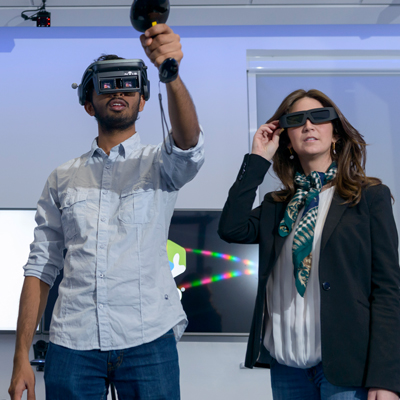Prototyping factories and their layouts using discrete event simulations and virtual reality enables virtual factories to be constructed, tested and ran before any money is spent building physical factories.
Key Facts
- We developed a link between Virtual Reality and a Discrete Event Simulation tool. This enabled us to actually disrupt the operations of virtual machines and see the effect these disruptions will have on factory production targets.
- We used human generated CAD models and simulation models to teach a computer vision algorithm, which enabled it to interpret physical locations and activities from visual inputs. This enabled a computer equipped with a camera to understand scene and process changes on a factory floor
- We used data, obtained via computer vision algorithms, to update simulation models so that they could be used to create more accurate predictions of future events.
Impact of our research
There is an increasing need to eliminate wasted time and money during factory layout design and subsequent construction. Currently it is difficult for engineers to foresee whether a certain layout is optimal for work and material flows. By exploiting modelling, simulation and visualisation techniques, this research developed a prototype called immersive WITNESS that combines the modelling strengths of Discrete Event Simulation (DES) with the 3D visualisation strengths of recent 3D low cost gaming technology to enable decision makers make informed design choices for future factories layouts. The prototype enables engineers to receive immediate feedback on their design choices. Our results show that this prototype has the potential to reduce rework as well as the associated costs of making physical prototypes.
The recent introduction of low-cost 3D sensing and affordable immersive virtual reality equipment has lowered the barriers for creating and maintaining 3D virtual worlds. In this research, we proposed a way to combine these technologies with discrete-event simulation to improve the use of simulation in decision making in manufacturing. We showed how sensor data from real world systems can be put directly into a simulation model to guide smart behaviours. Technologies included in the research include feedback from RGBD images of shop floor motion and human interactions.
Why the research was commissioned
The research was commissioned in response to an Innovate UK call that wanted to investigate the zero prototyping of factories.
As a result, this research investigated the design and development of a workflow that enabled factories to be constructed and ran in virtual environments before actual construction. By combining virtual reality gaming technology, a discrete event simulation platform and RGB-D cameras in an integrated framework, we were able to develop a prototype that enabled us to test factory layouts. Discrete event simulation models enabled us to carry out predictive analytics while RGB-D cameras gave us data streams that were used to ensure the models were up-to-date. The virtual reality environment immersed users in the virtually constructed environment giving them a feeling of being in the actual factory.
Why Cranfield?
Our close relationship with industry helped us get an understanding of the problem they were experiencing. As a result, it was possible to frame the problem as well as the potential solution in the research proposal. The application of gaming technology was also novel and we had 3-4 years track record in applying it to different problems. Furthermore, because our second partner’s industry was in developing simulation software, it was helpful to gain their input into challenges and possible future business cases thereby strengthening the proposal.
Facilities used
-
Manufacturing Informatics Lab
